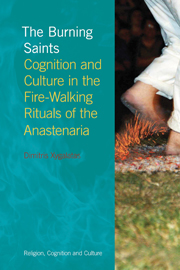Book contents
- Frontmatter
- Dedication
- Contents
- List of illustrations
- Acknowledgements
- 1 Introduction
- 2 Tradition in the making
- 3 The ethnographic setting
- 4 Fire-walking in Agia Eleni
- 5 Knowledge and revelation among the Anastenaria
- 6 Ritual and mind
- 7 Costly rituals
- 8 Arousal, emotion and motivation
- 9 The physiology of high-arousal rituals
- 10 Putting it all together
- Notes
- Bibliography
- Index
4 - Fire-walking in Agia Eleni
- Frontmatter
- Dedication
- Contents
- List of illustrations
- Acknowledgements
- 1 Introduction
- 2 Tradition in the making
- 3 The ethnographic setting
- 4 Fire-walking in Agia Eleni
- 5 Knowledge and revelation among the Anastenaria
- 6 Ritual and mind
- 7 Costly rituals
- 8 Arousal, emotion and motivation
- 9 The physiology of high-arousal rituals
- 10 Putting it all together
- Notes
- Bibliography
- Index
Summary
The presence of the tradition of the Anastenaria is readily felt in Agia Eleni. The village church is dedicated to Saints Constantine and Helen, while the village itself is named after Saint Helen. The specially designated area where the festival is celebrated, near the northern entrance to the village, unmistakably reveals its sacred importance. Fire-walking takes place in a circular field of about 30 m in diameter, fenced with low metal bars (see Fig. 4.1). Spectators stand behind the fence and the perennial scorch marks in the centre of the circle show where the fire is lit. On the one side of the circle lies a concrete deck, covered by a wooden roof, where chairs are placed for distinguished guests. On the other side and across the street is the konaki, the room where all the preparations and dancing take place. The konaki is a rectangular building, about 12 m long and 6 m wide, and each of its long sides has one door and two windows. It has a pitched roof and wooden floor.
Attached to the side of the konaki is a small kitchen, and behind it are the headquarters of the Cultural Society of Agia Eleni, where visitors can find a photographic archive of the Anastenaria. On the other side, there are two more buildings. One of them is the chapel (parekklisi), and the other is the agiasma (Fig. 4.2), the sacred well of the Anastenaria. According to tradition, some time after the Second World War some of the women had a dream in which Saint Constantine revealed to them the location of the well. They got up in the middle of the night and started digging, and soon they found water. Since then, this place has been considered a sacred well, and a structure has been built over it, with a staircase leading to the water.
- Type
- Chapter
- Information
- The Burning SaintsCognition and Culture in the Fire-Walking Rituals of the Anastenaria, pp. 61 - 90Publisher: Acumen PublishingPrint publication year: 2012



